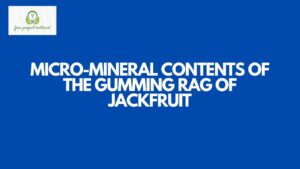ABSTRACT
The proximate analysis of Mucuna pruriens was analysed using the method of AOAC (1980). The caloric value was calculated from crude protein, crude fat, crude fibre, carbohydrate, moisture and ash content. The result shows that mucuna pruriens contain moisture 12.31±0.85, ash 31.09±0.127, crude fibre 11.69±0.092, crude fat 18.09±0.120, crude protein 2.20±0.040, carbohydrate 65.10±0.020. This study concluded that Mucuna pruriens is high in carbohydrate and low in crude protein.
TABLE OF CONTENTS
Title Page – – – – – – – – – i
Certification – – – – – – – – – ii
Dedication – – – – – – – – – iii
Acknowledgement – – – – – – – – iv
Abstract – – – – – – – – – v
Table of Content – – – – – – – – vi
CHAPTER ONE
1.0 Introduction – – – – – – – – 1
1.1 Background of the Study – – – – – 2
1.2 Aim and Objectives of the Study – – – – 2
1.3 Scope and Limitation of the Study – – – – 2
CHAPTER TWO
2.0 Literature Review – – – – – – – 3
2.1 Description of Mucuna puriens (velvet bean) – – 3
2.2 Origin of Mucuna puriens – – – – 5
2.3 Species of Mucuna puriens – – – – – 5-6
2.4 Proximate parameter – – – – – – 6-7
2.5 Moisture – – – – – – – – 7-9
2.6 Ash energy Value – – – – – – – 9-10
2.7 Crude fibre – – – – – – – – 10-12
2.8 Crude Fat – – – – – – – – 12-14
2.9 Protein – – – – – – – – 14-15
2.10 Carbohydrate – – – – – – – 15-16
CHAPTER THREE: MATERIALS AND METHOD
3.1 Materials – – – – – – – – 17
3.2 Methods – – – – – – – – 17
3.2.1 Sample Collection and Preparation – – – – 17
3.2.2 Determination of Proximate Composition – – – 18-22
CHAPTER FOUR: RESULT AND DISCUSSION
4.1 Result – – – – – – – – 23
4.2 Discussion – – – – – – – – 24-27
CHAPTER FIVE: CONCLUSION AND RECOMMENDATIONS
5.1 Conclusion – – – – – – – – 28
5.2 Recommendations – – – – – – – 29
5.3 References
CHAPTER ONE
1.0 INTRODUCTION
The genus Mucana belong to the fabaceae family. Sub family palionaceae includes approximately 150 species of annual and perennial legumes. Among the various under-utilized wild legumes, the velvet bean Mucuna pruriens is widespread in tropical and sub-tropical regions of the world. It is considered a viable source of dietary proteins (Janardhanan et al., 2003; Pugatenthi et al., 2005) due to its high protein concentration (23 – 35%) in addition its digestibility, which is compared to that of other pulses such as soyabean, rice bean, and lima bean (Gurumoorthi et al. 2003). It is therefore regarded a source of food.
The plant Mucuna pruriens is provided with different bioactive compounds that possess several pharmacological properties. Mucuna pruriens is an ethnomedicinal plant that possesses several medicinal benefits in treating diseases. Apart from its medicinal value, Mucuna puriens have high nutritional value as an edible plant where it serves as a mild laxative.
1.1 Background of the Study
The velvet bean seed are variable in colour, it is the most important medical plants. It is used to treat many ailments,
1.2 Aim and Objective of the Study
The aim and objective of this study is to determine the proximate analysis of Mucuna preuriens (velvet beans)
1.3 Scope and Limitation of the Study
This research work is limited to the proximate composition of Mucuna preuriens due to lack of funds and time.



